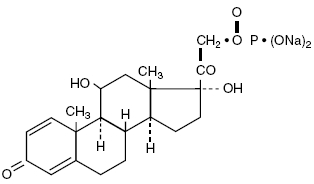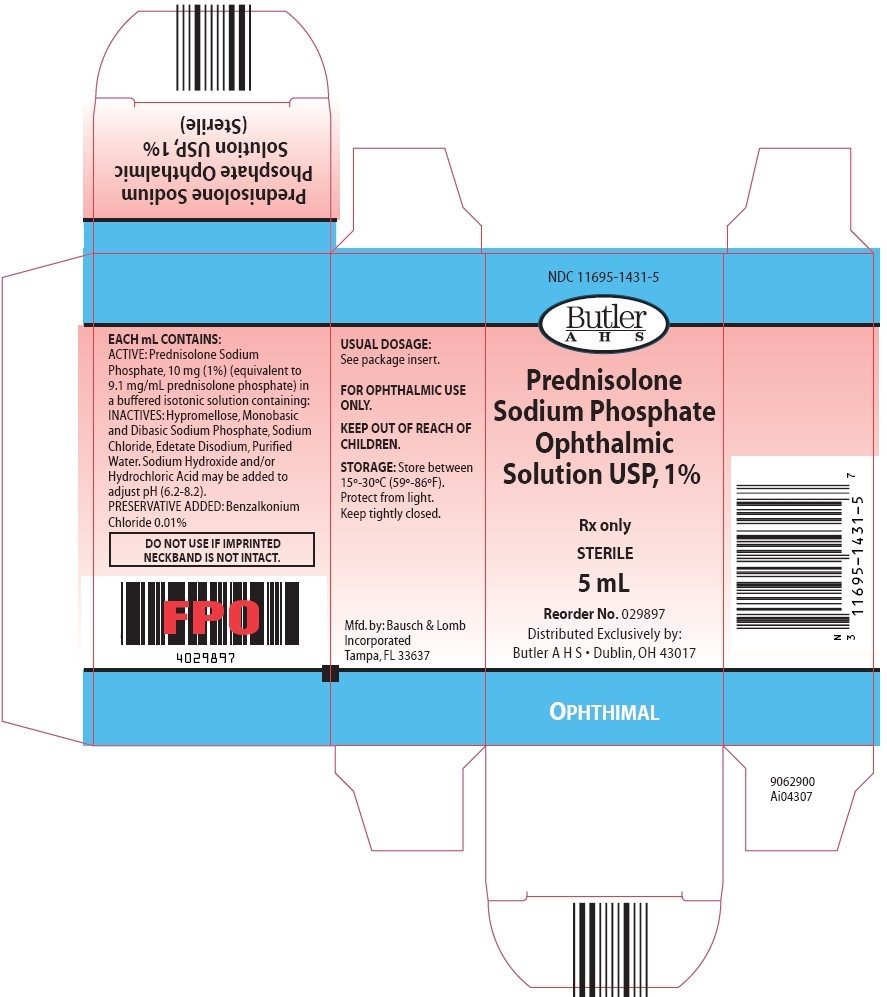PREDNISOLONE SODIUM PHOSPHATE solution/ drops
Prednisolone Sodium Phosphate by
Drug Labeling and Warnings
Prednisolone Sodium Phosphate by is a Prescription medication manufactured, distributed, or labeled by Butler Animal Health Supply, Bausch & Lomb Incorporated. Drug facts, warnings, and ingredients follow.
Drug Details [pdf]
- SPL UNCLASSIFIED SECTION
-
DESCRIPTION:
Prednisolone Sodium Phosphate Ophthalmic Solution, 1%, is a sterile solution for ophthalmic administration having the following composition:
Each mL Contains:
ACTIVE: Prednisolone Sodium Phosphate 10 mg (1%) [equivalent to 9.1 mg/mL prednisolone phosphate] in a buffered isotonic solution containing INACTIVES: Hypromellose, Monobasic and Dibasic Sodium Phosphate, Sodium Chloride, Edetate Disodium and Purified Water. Sodium Hydroxide and/or Hydrochloric Acid may be added to adjust the pH (6.2 - 8.2).
PRESERVATIVE ADDED: Benzalkonium Chloride 0.01%.The chemical name for prednisolone sodium phosphate is Pregna-1, 4-diene - 3, 20-dione, 11, 17-dihydroxy-21-(phosphonooxy)-, disodium salt, (11 β) -, which has the following structural formula:

Molecular formula: C21H27Na2O8P
Molecular Weight: 484.39
- CLINICAL PHARMACOLOGY:
-
INDICATIONS AND USAGE:
Prednisolone Sodium Phosphate Ophthalmic Solution 1% or 1/8% is for the treatment of steroid responsive inflammatory conditions of the palpebral and bulbar conjunctiva, cornea, and anterior segment of the globe, such as allergic conjunctivitis, acne rosacea, superficial punctate keratitis, herpes zoster keratitis, iritis, cyclitis, selected infective conjunctivitis when the inherent hazard of steroid use is accepted to obtain an advisable diminution in edema and inflammation, corneal injury from chemical, radiation, or thermal burns, or penetration of foreign bodies.
Prednisolone Sodium Phosphate Ophthalmic Solution, 1%, is recommended for moderate to severe inflammations, particularly when unusually rapid control is desired. In stubborn cases of anterior segment eye disease, systemic adrenocortical hormone therapy may be required. When deeper ocular structures are involved, systemic therapy is necessary.
-
CONTRAINDICATIONS:
The use of this preparation is contraindicated in the presence of:
1] Acute superficial herpes simplex keratitis.
2] Fungal diseases of ocular structures.
3] Acute infectious stages of vaccinia, varicella and most other viral diseases of the cornea and conjunctiva.
4] Tuberculosis of the eye.
5] Hypersensitivity to a component of this medication.
The use of this preparation is always contraindicated after uncomplicated removal of a superficial corneal foreign body.
-
WARNINGS:
NOT FOR INJECTION INTO EYE - FOR TOPICAL USE ONLY
Employment of steroid medication in the treatment of herpes simplex keratitis involving the stroma requires great caution; frequent slit-lamp microscopy is mandatory.
Prolonged use may result in elevated intraocular pressure and/or glaucoma, damage to the optic nerve, defects in visual acuity and fields of vision, posterior subcapsular cataract formation, or may aid in the establishment of secondary ocular infections from pathogens liberated from ocular tissues. In those diseases causing thinning of the cornea or sclera, perforation has been known to occur with the use of topical steroids. Acute purulent untreated infection of the eye may be masked or activity enhanced by presence of steroid medication. Viral, bacterial, and fungal infections of the cornea may be exacerbated by the application of steroids.
This drug is not effective in mustard gas keratitis and Sjögren’s keratoconjuncitivitis.
If irritation persists or develops, the patient should be advised to discontinue use and consult prescribing physician.
-
PRECAUTIONS
General:
As fungal infections of the cornea are particularly prone to develop coincidentally with long-term steroid applications, fungus invasion must be suspected in any persistent corneal ulceration where a steroid has been used or is in use.
Intraocular pressure should be checked frequently.
Information for Patients:
Do not touch dropper tip to any surface as this may contaminate the solution.
Usage in Pregnancy:
Pregnancy Category C: Animal reproductive studies have not been conducted with prednisolone sodium phosphate. It is also not known whether prednisolone sodium phosphate can cause fetal harm when administered to a pregnant woman or can affect reproductive capacity. Prednisolone sodium phosphate should be given to a pregnant woman only if clearly needed.
The effect of prednisolone sodium phosphate on the later growth, development and functional maturation of the child is unknown.
-
ADVERSE REACTIONS:
Glaucoma with optic nerve damage, visual acuity and field defects, posterior subcapsular cataract formation, secondary ocular infections from pathogens including herpes simplex and fungi, and perforation of the globe.
Rarely, filtering blebs have been reported when topical steroids have been used following cataract surgery.
Rarely, stinging, or burning may occur.
-
DOSAGE AND ADMINISTRATION:
Depending on the severity of inflammation, instill one or two drops of solution into the conjunctival sac up to every hour during the day and every two hours during the night as necessary as initial therapy.
When a favorable response is observed, reduce dosage to one drop every four hours.
Later, further reduction in dosage to one drop three to four times daily may suffice to control symptoms.
The duration of treatment will vary with the type of lesion and may extend from a few days to several weeks, according to therapeutic response. Relapses, more common in chronic active lesions than in self-limited conditions, usually respond to retreatment.
- HOW SUPPLIED:
-
PACKAGE/LABEL PRINCIPAL DISPLAY PANEL

NDC: 11695-1431-5
Prednisolone Sodium Phosphate Ophthalmic Solution USP, 1%
Rx only
STERILE
5mL
Reorder No. 029897
Distributed Exclusively by:
Butler AHS Dublin, OH 43017
OPHTHIMAL
-
INGREDIENTS AND APPEARANCE
PREDNISOLONE SODIUM PHOSPHATE
prednisolone sodium phosphate solution/ dropsProduct Information Product Type HUMAN PRESCRIPTION DRUG Item Code (Source) NDC: 11695-1431 Route of Administration OPHTHALMIC Active Ingredient/Active Moiety Ingredient Name Basis of Strength Strength PREDNISOLONE SODIUM PHOSPHATE (UNII: IV021NXA9J) (PREDNISOLONE - UNII:9PHQ9Y1OLM) PREDNISOLONE SODIUM PHOSPHATE 10 mg in 1 mL Inactive Ingredients Ingredient Name Strength BENZALKONIUM CHLORIDE (UNII: F5UM2KM3W7) SODIUM PHOSPHATE, DIBASIC (UNII: GR686LBA74) EDETATE DISODIUM (UNII: 7FLD91C86K) HYDROCHLORIC ACID (UNII: QTT17582CB) HYPROMELLOSES (UNII: 3NXW29V3WO) SODIUM PHOSPHATE, MONOBASIC (UNII: 3980JIH2SW) WATER (UNII: 059QF0KO0R) SODIUM CHLORIDE (UNII: 451W47IQ8X) SODIUM HYDROXIDE (UNII: 55X04QC32I) Packaging # Item Code Package Description Marketing Start Date Marketing End Date 1 NDC: 11695-1431-5 1 in 1 CARTON 1 5 mL in 1 BOTTLE, DROPPER Marketing Information Marketing Category Application Number or Monograph Citation Marketing Start Date Marketing End Date ANDA ANDA040070 07/29/1994 Labeler - Butler Animal Health Supply (017880659) Registrant - Bausch & Lomb Incorporated (196603781) Establishment Name Address ID/FEI Business Operations Bausch & Lomb Incorporated 807927397 MANUFACTURE
© 2025 FDA.report
This site is not affiliated with or endorsed by the FDA.